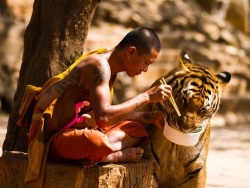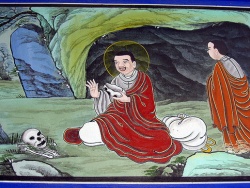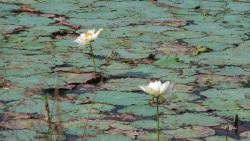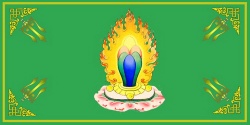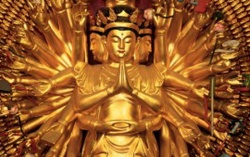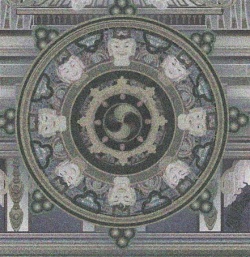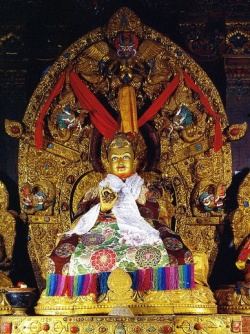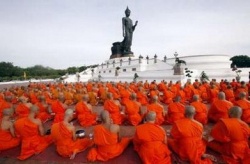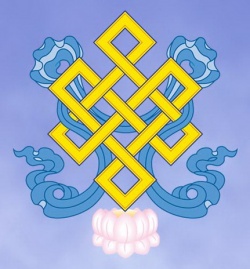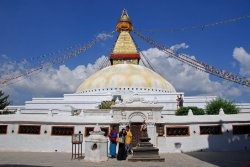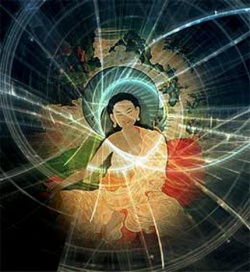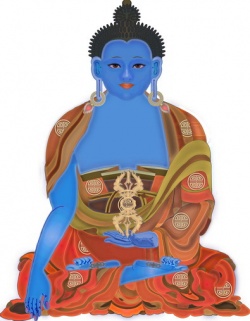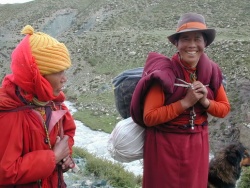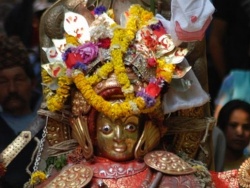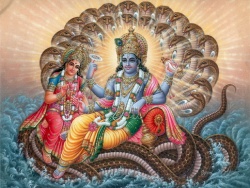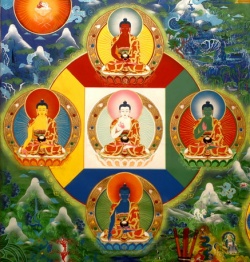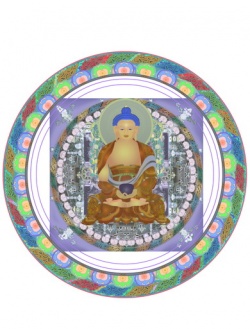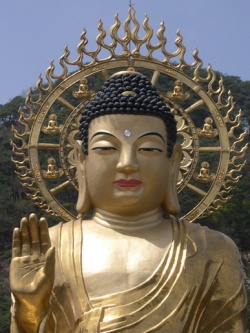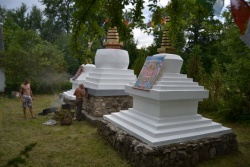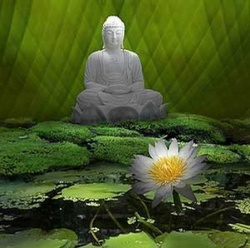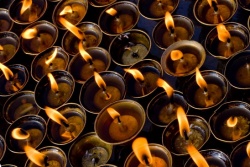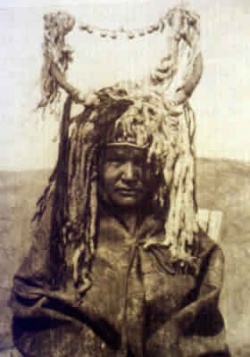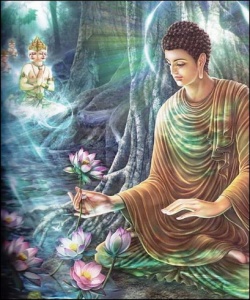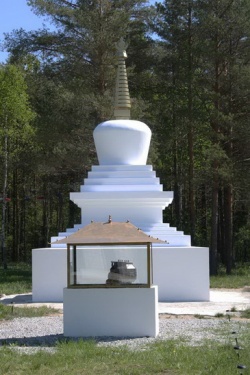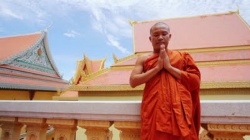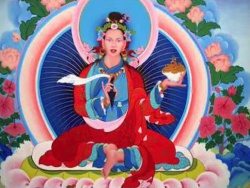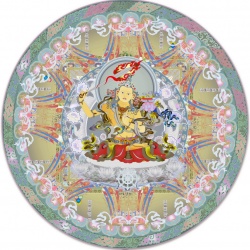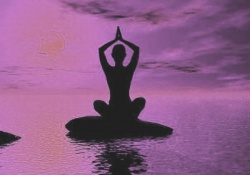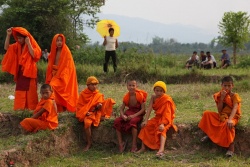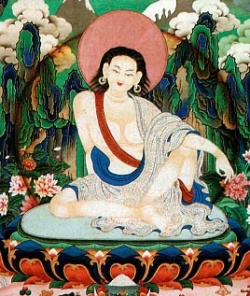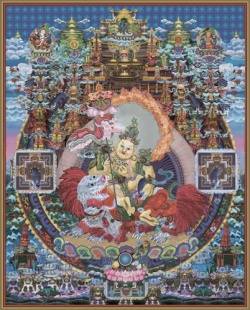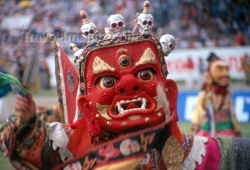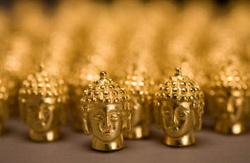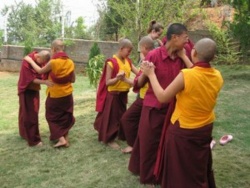Xuanzang's Record of the Western Regions
composed by the Buddhist pilgrim in 646 at the request of the Tang Emperor
translated by Samuel Beal (1884)
Xuanzang was a Chinese Buddhist monk and translator who traveled across the Tarim basin via the northern route, Turfan, Kucha, Tashkent, Samarkand, Bactria, then over the Hindu Kush to India. He departed the Tang capitol (Chang'an) in 629 and returned via the southern route in 645. The remainder of his life was spent translating into Chinese the sutras which he had collected in India. At the request of the Tang Emperor Taizong (r.626-649) he composed a description of the lands through which he traveled. After his death, his travels and story became fantastic legends which were used in plays and novels. The following text constitutes Book One of his description. It is taken from the translation of Samuel Beal, Buddhist Records of the Western World (London: Trubner & Co. Ltd., 1884), the original page numbers of which are given throughout the text in the format //[p.xx].
//[p.7] If we examine in succession the rules of the emperors, or look into the records of the monarchs, when P'au I began to adjust matters and Hien-yuen began to let //[p.8] fall his robes, we see how they administered the affairs, and first divided the limits of the empire.
When Tang(-ti) Yao received the call of heaven (to mule), his glory reached to the four quarters; when Yu(-ti) Shun had received his map of the earth, his virtue flowed throughout the nine provinces. From that time there have come down clear records, annals of events; though distant, we may hear the previous doings (of eminent men), or gather their words from the records of their disciples. How much rather when we live under a renowned government, and depend on those without partial aims. Now then our great Tang emperor (or dynasty), conformed in the highest degree to the heavenly pattern, now holds the reins of government, and unites in one the six parts of the world, and is gloriously established. Like a fourth august monarch, he illustriously administers the empire. His mysterious controlling power flows afar; his auspicious influence (fame or instruction) widely extends: like the heaven and the earth, he covers and sustains (his subjects), or like the resounding wind or the fertilising rain. The eastern barbarians bring him tribute; the western frontiers are brought to submission. He has secured and hands down the succession, appeasing tumult, restoring order. He certainly surpasses the previous kings; he //[p.9] embraces in himself the virtues of former generations. Using the same currency (or literature), all acknowledge his supreme rule. If his sacred merit be not recorded in history; then it is vain to exalt the great (or his greatness); if it be not to illumine the world, why then -shine so brilliantly his mighty deeds?
Xuanzang, wherever he bent his steps, has described the character of each country. Although he has not examined the country or distinguished the customs (in every case), he has shown himself trustworthy. Is with respect to the emperor who transcends the five and surpasses the three, we read how all creatures enjoy his benefits, and all who can declare it utter his praises. From the royal city throughout the (five) Indies, men who inhabit the savage wilds, those whose customs are diverse from ours, through the most remote lands, all have received the royal calendar, all have accepted the imperial instructions; alike they praise his warlike merit and sing of his exalted virtues and his true grace of utterance. This is the first thing to be declared. In searching through previous annals no such thing has been seen or heard of. In all the records of biography no such an account has been found. It was necessary first to declare the benefits arising from the imperial rule: now we proceed to narrate facts, which have been gathered either by report or sight, as follows.
This Sahalôka (Soh-ho) world is the three-thousand-//[p.10] great-thousand system of worlds (chiliocosm), over which one Buddha exercises spiritual authority (converts and controls). In the middle of the great chiliocosm, illuminated by-one sun and moon, are the four continents, in which all the Buddhas, lords of the world, appear by apparitional birth, and here also die, for the purpose of guiding holy men and worldly men.
The mountain called Sumêru stands up in the midst of the great sea firmly fixed on a circle of gold, around which mountain the sun and moon revolve; this mountain is perfected by (composed of) four precious substances, and is the abode of the Dêvas. Around this are seven mountain-ranges and seven seas; between each range a flowing sea of the eight peculiar qualities. Outside the seven //[p.11] golden mountain-ranges is the salt sea. There are four lands (countries or islands, duîpas) in the salt sea, which are inhabited. On the east, (Pûrva) vidêha; on the south, Jambudvîpa; on the west, Gôdhanya; on the north, Kurudvîpa:
A golden-wheel monarch rules righteously the four; a silver-wheel monarch rules the three (excepting Kuru); a copper-wheel monarch rules over two (excepting Kuru and Godhanya); and an iron-wheel monarch rules over Jambudvipa only. When first a wheel- king is established in power a great wheel-gem appears floating in space, and coming towards him; its character--whether gold, silver, copper, or iron--determines the king's destiny and his name.
In the middle of Jambudvipa there is a lake called Anavatapta to the south of the Fragrant Mountains and to the north of the great Snowy Mountains; it is 800 li and more in circuit; its sides are composed of bold, silver, lapis-lazuli, and crystal; golden sands lie at the bottom, and its waters are clear as a mirror. The great earth Bodhisattva, by the power of his vow, transforms himself into a Naga-raja and dwells therein; from his dwelling the cool waters proceed forth and enrich Jambudvipa (Shen-pu-chau).
From the eastern side of the lake, through the mouth of a silver ox, flows the Ganaes (King-kia) river; encircling the lake once, it enters the south-eastern sea.
//[p.12] From the south of the lake, through a golden elephant's mouth, proceeds the Sindhu (Sin-to) river; encircling the lake once, it flows into the south-western sea.
From the western side of the lake, from the mouth of a horse of lapis-lazuli, proceeds the river Vakahu (Po-tsu), and encircling the lake once, it falls into the north-western sea. From the north side of the lake, through the mouth of a crystal lion, proceeds the river- S4ta (Si- to), and encircling the lake once, it falls into the north-eastern sea. //[p.13] They also say that the streams of this river Sita, entering the earth, flow out beneath the Tsih rock mountain, and give rise to the river of the middle country (China).
At the time when there is no paramount wheel-monarch, then the land of Jambudvipa has four rulers.
On the south "the lord of elephants;" the land here is warm and humid, suitable for elephants, On the west "the lord of treasures;" the land borders on the sea, and abounds in Gems. On the north "'the lord of horses;" the country is cold and hard, suitable for horses. On the east "the lord of men;" the climate is soft and //[p.14] agreeable (exhilarating), and therefore there are many men.
In the country of "the lord of elephants" the people are quick and enthusiastic, and entirely given to learning. They cultivate especially magical arts. They wear a robe thrown across them, with their right shoulder bare; their hair is done up in a ball on the top, and left undressed on the four sides. Their various tribes occupy different towns; their houses are built stage over stage.
In the country of "the lord of treasures" the people have no politeness or justice. They accumulate wealth. Their dress is short, with a left skirt. They cut their hair and cultivate their moustache. They dwell in walled towns and are eager in profiting by trade.
The people of the country of "the lord of horses" are naturally (t'ien tsz') wild and fierce. They are cruel in disposition; they slaughter (animals) and live under large felt tents; they divide like birds (going here and there) attending their flocks.
The land of "the lord of men" is distinguished for the wisdom and virtue and justice of the people. They wear a head-covering and a girdle; the end of their dress //[p.15] (girdle) hangs to the right. They have carriages and robes according to rank; they cling to the soil and hardly ever change their abode; they are very earnest in work, and divided into classes.
With respect to the people belonging to these three rulers, the eastern region is considered the best; the doors of their dwellings open towards the east, and when the sun rises in the morning they turn towards it and salute it. In this country the south side is considered the most honourable. Such are the leading characteristics in respect of manners and customs relating to these regions.
But with regard to the rules of politeness observed between the prince and his subjects, between superiors and inferiors, and with respect to laws and literature, the land of "the lord of men" is greatly in advance. The country of "the lord of elephants" is distinguished for rules which relate to purifying the heart and release from the ties of life and death; this is its leading excellency. With these things the sacred books and the royal decrees are occupied. Hearing the reports of the native races and diligently searching out things old and new, and exarnining those things which came before his eyes and ears, it is thus he (i.e., Xuanzang) obtained information.
Now Buddha having been born in the western region and his religion having spread eastwards, the sounds of the words translated have been often mistaken, the phrases of the different regions have been misunderstood on account of the wrong sounds, and thus the sense has been lost. The words being wrong, the idea has been perverted. Therefore, as it is said, "it is indispensable to have the right names, in order that there be no mistakes."
Now, men differ according to the firmness or weakness of their nature, and so the words and the sounds (of their languages) are unlike. This may be the result either of //[p.16] climate or usage. The produce of the soil differs in the same way, according to the mountains and valleys. With respect to the difference in manners and customs, and also as to the character of the people in the country of "the lord of men," the annals sufficiently explain this. In the country of "the lord of horses" and of "the lord of treasures" the (local) records and the proclamations explain the customs faithfully, so that a brief account can be given of them.
In the country of "the lord of elephants" the previous history of the people is little known. The country is said to be in general wet and warm, and it is also said that the people are virtuous and benevolent. With respect to the history of the country, so far as it has been preserved, we cannot cite it in detail; whether it be that the roads are difficult of access, or on account of the revolutions which have occurred, such is the case. In this way we see at least that the people only await instruction to be brought to submission, and when they have received benefit they will enjoy the blessing of civilization (pay homage). How difficult to recount the list of those who, coming from far, after encountering the greatest perils (difficulties), knock at the gem-gate with the choice tribute of their country and pay their reverence to the emperor. Wherefore, after he (Xuanzang) had travelled afar in search of the law, in his moments of leisure he has preserved these records of the character of the lands (visited). After leaving the black ridge, the manners of the people are savage (barbarous). Although the barbarous tribes are intermixed one with the other, yet the different races are distinguishable, and their territories have well-defined boundaries. Generally speaking, as the land suits, they build walled towns and devote themselves to agriculture and raising cattle. They //[p.17] naturally hoard wealth and hold virtue and justice in light esteem. They have no marriage decorum, and no distinction of high or low. The women say, "I consent to use you as a husband and live in submission, (and that is all)." When dead, they burn the body, and there is no determined period for mourning. They scar their faces and cut their ears. They crop their hair and tear their clothes. They slay their herds and offer them in sacrifice to the manes of the dead. When rejoicing, they wear white garments; when in mourning, they clothe themselves in black. Thus we have described briefly points of agreement in the manners and customs of these people. The differences of administration depend on the different countries. With respect to the customs of India, they are contained in the following records.
Leaving the old country of Kau-chane, from this neighbourhood there begins what is called the 'O-ki-ni country.
'O-KI-NI (Anciently called Wu-ki).
The kingdom of 'O-ki-ni (Akni or Aani) is about 500 li from east to west, and about 400 li from north to south. //[p.18] The chief town of the realm is in circuit 6 or 7 li. On all sides it is girt with hills. The roads are precipitous and easy of defence. Numerous streams unite, and are led in channels to irrigate the fields. The soil is suitable for red millet, winter wheat, scented dates, grapes, pears, and plums, and other fruits. The air is soft and agreeable; the manners of the people are sincere and upright. The written character is, with few differences, like that of India. The clothing (of the people) is of cotton or wool. They go with shorn locks and without head-dress. In commerce they use gold coins, silver coins, and little copper coins. The king is a native of the country; he is brave, but little attentive to (military) plans, yet he loves to speak of his own conquests. This country has no annals. The laws are not settled. There are some ten or more Sanghârâmas with two thousand priests or so, belonging to the Little Vehicle, of the school of the Sarvâstivâdas (Shwo-yih-tsai-yu- po). The doctrine of the Sutras and the requirements of the Vinaya are in agreement with those of India, and the books from which they study are the same. The professors of religion read their books and observe the rules and regulations with purity and strictness. They only eat the three pure aliments, and observe the method known as the"gradual" one.
Going south-west from this country 200 li or so, surmounting a small mountain range and crossing two large rivers, passing westwards through a level valley some 700 li or so, we come to the country of K'iu-chi (anciently written Ii uei-tzu). //[p.19]
Kingdom of K'iu-Chi (Kuchê)
The country of K'iu-chi is from east to west some thousand li or so; from north to south about 600 li. The capital of the realm is from 17 to 18 li in circuit. The soil is suitable for rice and corn, also (a kind of rice called) keng-t'ao; produces grapes, pomegranates, and nu- merous species of plums, pears, peaches, and almonds, also grow here. The ground is rich in minerals--gold, copper, iron, and lead, and tin. The air is soft, and the manners of the people honest. The style of writing (literature) is Indian, with some differences. They excel other countries in their skill in playing on the lute and pipe. They clothe themselves with ornamental garments of silk and embroidery. They cut their hair and wear a flowing covering (over their heads). In commerce they use gold, silver, and copper coins. The king is of the K'iu-chi race; his wisdom being small, he is ruled by a powerful minister. The children born of common parents have their heads flattened by the pressure of a wooden board.
There are about one hundred convents (sangharamas) in this country, with five thousand and more disciples. These belong to the Little Vehicle of the school of the Sarvistivadas (Shwo-yih-tsai-yu-po). Their doctrine (teaching of Sutras) and their rules of discipline (principles of the Vinaya) are like those of India, and those who read them use the same (originals). They especially hold to the //[p.20] customs of the "gradual doctrine," and partake only of the three pure kinds of food. They live purely, and provoke others (by their conduct) to a religious life.
To the north of a city on the eastern borders of the country, in front of a Dêva temple, there is a Great dragonlake. The dragons, changing their form, couple with mares. The offspring is a wild species of horse (dragon horse), difficult to tame and of a fierce nature. The breed of these dragon-horses became docile: This country consequently became famous for its many excellent horses. Former records (of this country) say: "In late times there was a king called 'Gold Flower,' who exhibited rare intelligence in the doctrines (of religion). He was able to yoke the dragons to his chariot. When the king wished to dis- appear, he touched the ears of the dragons with his whip, and forthwith he became invisible."
From very early time till now there have been no wells in the town, so that the inhabitants have been accustomed to get water from the dragon lake. On these occasions the dragons, changing themselves into the likeness of men, had intercourse with the women. Their children, when born, were powerful and courageous, and swift of foot as the horse. Thus gradually corrupting themselves, the men all became of the dragon breed, and relying on their strength, they became rebellious and disobedient to the royal authority. Then the king, forming an alliance with the Tuh-kiueh (Turks), massacred the men of the city; young and old, all were //[p.21] destroyed, so that there was no remnant left; the city is now a waste and uninhabited.
About 40 li to the north of this desert city there are two convents close together on the slope of a mountain, but separated by a stream of water, both named Chau-hu-li, being situated east and west of one another, and accordingly so called. (Here there is) a statue of Buddha, richly adorned and carved with skill surpassing that of men. The occupants of the convents are pure and truthful, and diligent in the discharge of their duties. In (the hall of) the eastern convent, called the Buddha pavilion, there is a jade stone, with a surface of about two feet in width, and of a yellowish white colour; in shape it is like a sea-shell; on its surface is a foot trace of Buddha, 1 foot 8 inches long, and eight inches or so in breadth; at the expiration of every fast-day it emits a bright and sparkling light.
Outside the western gate of the chief city, on the right and left side of the road, there are (two) erect figures of Buddha, about 90 feet high. In the space in front of these statues there is a place erected for the quinquennial assembly. Every year at the autumnal equinox, during ten several days, the priests assemble from all the country in this place. The king and all his people, from the highest to the lowest, on this occasion abstain from public business, and observe a religious fast; they listen to the //[p.22] sacred teachings of the law, and pass the days without weariness.
In all the convents there are highly adorned images of Buddha, decorated with precious substances and covered with silken stuffs. These they carry (on stated occasions) in idol-cars, which they call the "procession of images." On these occasions the people flock by thousands to the place of assembly.
On the fifteenth and last day of the month the king of the country and his ministers always consult together respecting affairs of state, and after taking counsel of the chief priests, they publish their decrees.
To the north-west of the meeting-place we cross a river and arrive at a convent called 'O- she-li-ni. The hall of this temple is open and spacious. The image of Buddha is beautifully carved. The disciples (religious) are brave and decorous and very diligent in their duties; rude and rough (men) come here together; the aged priests are learned and of great talent, and so from distant spots the most eminent men who desire to acquire just principles come here and fix their abode. The king and his ministers and the great men of the realm offer to these priests the four sorts of provision, and their celebrity spreads farther and farther.
The old records say: "A former king of this country worshipped the 'three precious' ones. Wishing to pay homage to the sacred relics of the outer world, he entrusted the affairs of the empire to his younger brother on the mother's side. The younger brother having received such orders, mutilated himself in order to prevent any evil risings (of passion). He enclosed the mutilated //[p.23] parts in a golden casket, and laid it before the king. 'What is this?' inquired the king. In reply he said, 'On the day of your majesty's return home, I pray you open it and see.' The king gave it to the manager of his affairs, who intrusted the casket to a portion of the king's bodyguard to keep. And now, in the end, there were certain mischief-making people who said, 'The king's deputy, in his absence, has been debauching himself in the inner rooms of the women.' The king hearing this, was very angry, and would have subjected his brother to cruel punishment. The brother said, 'I dare not flee from punishment, but I pray you open the golden casket.' The king accordingly opened it, and saw that it contained a mutilated member. Seeing it, he said, 'What strange thing is this, and what does it signify?' Replying, the brother said, 'Formerly, when the king proposed to go abroad, he ordered me to undertake the affairs of the government. Fearing the slanderous reports that might arise, I mutilated myself. You now have the proof of my foresight. Let the king look benignantly on me.' The king was filled with the deepest reverence and strangely moved with affection; in consequence, he permitted him free ingress and egress throughout his palace.
"After this it happened that the younger brother, going abroad, met by the way a herdsman who was arranging to geld five hundred oxen. On seeing this, he gave himself to reflection, and taking himself as an example of what they were to suffer, he was moved with increased compassion, (and said), 'Are not my present sufferings the consequence of my conduct in some former condition of life?' He forthwith desired with money and precious jewels to redeem this herd of oxen. In consequence of this act of love, he recovered by degrees from mutilation, and on this account he ceased to enter the apartments of the women. The king, filled with wonder, asked him the //[p.24] reason of this, and having heard the matter from beginning to end, looked on him as a 'prodigy' (khi- teh), and from this circumstance the convent took its name, which he built to honour the conduct of his brother and perpetuate his name."
After quitting this country and going about 600 li to the west, traversing a small sandy desert, we come to the country of Poh-luh-kia.
POA-LUH-KIA [BÂLUKÂ] (Formerly called Che-meh or Kih-meh).
The kingdom of Poh-luh-kia is about 600 li from east to west, and 300 li or, so from north to south. The chief town is 5 or 6 li in circuit. With regard to the soil, climate, character of the people, the customs, and literature (laws of composition), these are the same as in the country of g'iu-chi. The language (spoken language) differs however a little. It produces a fine sort of cotton and hair-cloth, which are highly valued by neighboring (frontier) countries.
There are some ten sangharamas here; the number of priests (priests and followers) is about one thousand. These follow the teaching of the "Little Vehicle," and belong to the school of the Sarvastivadas (Shwo-yih-tsai-yu-po).
//[p.25] Going 300 li or so to the north-west of this country, crossing a stony desert, we come to Ling-shan (ice-mountain). This is, in fact, the northern plateau of the T'sung-ling range and from this point the waters mostly have an eastern flow. Both hills and valleys are filled with snowpiles, and it freezes both in spring and summer; if it should thaw for a time, the ice soon forms again. The roads are steep and dangerous, the cold wind is extremely biting, and frequently fierce dragons impede and molest travellers with their inflictions. Those who travel this road should not wear red garments nor carry loud- sounding calabashes. The least forgetfulness of these precautions entails certain misfortune. A violent wind suddenly rises with storms of flying sand and gravel; those who encounter them, sinking through exhaustion, are almost sure to die. Going 400 li or so, we come to the great Tsing lake.
//[p.26] This lake is about 1000 li in circuit, extended from east to west, and narrow from north to south. On all sides it is enclosed by mountains, and various streams empty themselves into it and are lost. The colour of the water is a bluish-black, its taste is bitter and salt. The waves of this lake roll along tumultuously as they expend themselves (on the shores). Dragons and fishes inhabit it together. At certain (portentous) occasions scaly monsters rise to the surface, on which travellers passing by put up their prayers for good fortune. Although the water animals are numerous, no one dares (or ventures) to catch them by fishing. Going 500 li or so to the north-west of the Tsing lake, we arrive at the town of the Su-yeh river. This town is about 6 or 7 li in circuit; here the merchants from surrounding countries congregate and dwell.
The soil is favourable for red millet and for grapes; the woods are not thick, the climate is windy and cold; the people wear garments of twilled wool.
Passing on from Su-yeh westward, there are a great number of deserted towns; in each there is a chieftain (or over each there is established a chief); these are not dependent on one another, but all are in submission to the Tuh-kiueh.
From the town of the Su-yeh river as-far as the Kishwang-na country the land is called Su-li, and the people are called by the same name. The literature (written characters) and the spoken language are likewise so called. The primary characters are few in the beginning //[p.27] they were thirty or so in number: the words are composed by the combination of these; these combinations have produced a large and varied vocabulary. They have some literature, which the common sort read together; their mode of writing is handed down from one master to another without interruption, and is thus preserved. Their inner clothing is made of a fine hair-cloth (linen); their outer garments are of skin, their lower garments of linen, short and tight. They adjust their hair so as to leave the top of the head exposed (that is, they shave the top of their heads). Sometimes they shave their hair completely. They wear a silken band round their foreheads. They are tall of stature, but their wills are weak and pusillanimous. They are as a rule crafty and deceitful in their conduct and extremely covetous. Both parent and child plan how to get wealth; and the more they get the more they esteem each other; but the well-to-do and the poor are not distinguished; even when immensely rich, they feed and clothe themselves meanly. The strong bodied cultivate the land; the rest (half) engage in money-getting (business).
Going west from the town Su-yeh 400 li or so, we come to the "Thousand springs." This territory is about 200 li square. On the south are the Snowy Mountains, on the other sides (three boundaries) is level tableland. The soil is well watered; the trees afford a grateful shade, and the flowers in the spring months are varied and like //[p.28] tapestry. There are a thousand springs of water and lakes here, and hence the name. The Khan of the Tuh-kiueh comes to this place every (year) to avoid the heat. There are a number of deer here, many of which are ornamented with bells and rings; they are tame and not afraid of the people, nor do they run away. The Khan is very fond of them, and has forbidden them to be killed on pain of death without remission; hence they are preserved and live out their days.
Going from the Thousand springs westward 140 or 150 li, we come to the town of Ta-lo-sse (Taras). This town is 8 or 9 li in circuit; merchants from all parts assemble and live here with the natives (Tartars). The products and the climate are about the same as Su-yeh.
Going 10 li or so to the south, there is a little deserted town. It had once about 300 houses, occupied by people of China. Some time ago the inhabitants were violently carried off by the Tuh-kiueh, but afterwards assembling a number of their countrymen, they occupied this place in common. Their clothes being worn out, they adopted the Turkish mode of dress, but they have preserved their own native language and customs.
//[p.29] Going 200 li or so south-west from this, we come to the town called Peh-shwui ("White Water"). This town is 6 or 7 li in circuit. The products of the earth and the climate are very superior to those of Ta-to-sse.
Going 200 li or so to the south-west, we arrive at the town of Kong-yu, which is about 5 or 6 li in circuit. The plain on which it stands is well watered and fertile, and the verdure of the trees grateful and pleasing. From this going south 40 or 50 li, we come to the country of Nu-chih-kien.
NU-CHIH-KIEN [NUJKEND].
The country of Nu-chih-kien is about 1000 li in circuit; the land is fertile, the harvests are abundant, the plants and trees are rich in vegetation, the flowers and //[p.30] fruit plentiful and agreeable in character. This country is famous for its grapes: There are some hundred towns which are governed by their own separate rulers. They are independent in all their movements. But though they are so distinctly divided one from the other, they are all called by the general name of Nu-chih-kien.
Going hence about 200 li west, we come to the country of Che-shi (stony country).
CHE-SHI [CHÂJ].
The country of Che-shi is 1000 or so li in circuit. On the west it borders on the river Yeh. It is contracted towards the east and west, and extended towards the north and south. The products and climate are like those of Nu-chih-kien.
There are some ten towns in the country, each governed by its own chief; as there is no common sovereign over them, they are all under the yoke of the Tuh-kiueh. From this in a south-easterly direction some 1000 li or so, there is a country called Fei-han.
FEI-HAN [FERGHÂNAH].
This kingdom is about 4000 li in circuit. It is enclosed by mountains on every side. The soil is rich and fertile, it produces many harvests, and abundance of flowers and fruits. It is favourable for breeding sheep and horses. The climate is windy and cold. The character of the people is one of firmness and courage. Their language differs from that of the neighbouring countries. Their form is rather poor and mean. For ten years or so the country has had no supreme ruler. The strongest rule by force, and are independent one of another. They divide their separate possessions according to the run of the valleys and mountain barriers. Going from this country westward for 1000 li or so, we come to the kingdom of Su-tu-li-sse-na.
SU-TU-LI-SSE-NA [SUTRISHNA].
The country of Su-tu-li-sse-na " is some 1400 or 1500 li in circuit. - On the east it borders on the Y e h river (Jaxartes). This river has its source in the northern plateau of the Tsung-ling range, and flows 'to the northwest ; sometimes it rolls its muddy waters along in quiet, at other times with turbulence. The products and customs //[p.32] of the people are like those of Che-shi. Since it has had a king, it has been under the rule of the Turks.
North-west 100 from this we enter on a great sandy desert, where there is neither water nor grass. The road is lost in the waste, which appears boundless, and only by looking in the direction of some great mountain, and following the guidance of the bones which lie scattered about, can we know the way in which we ought to go.
SÂ-MO-KIEN [SAMARKAND].
The country of Sa-mo-kien is about 1600 or 1700 li in circuit. From east to west it is extended, from north to south it is contracted. The capital of the country is 20 li or so in circuit. It is completely enclosed by rugged land and very populous. The precious merchandise of many foreign countries is stored up here. The soil is rich and productive, and yields abundant harvests. The forest trees afford a thick vegetation, and flowers and fruits are plentiful. The Shen horses are bred here. The inhabitants are skilful in the arts and trades beyond those of other countries. The climate is agreeable and temperate. The people are brave and energetic. This country is in the middle of the Hu people (or this is the middle //[p.33] of the Hu). They are copied by all surrounding people in point of politeness and propriety. The king is full of courage, and the neighbouring countries obey his commands. The soldiers and the horses (cavalry) are strong and numerous, and principally men of Chih-kia. These men of Chih-kia are naturally brave and fierce, and meet death as a refuge (escape or salvation). When they attack, no enemy can stand before them. From this going south-east, there is a country called Mi-mo-h o.
MI-MO-HO [MAGHIAN].
The country Mi-mo-ho is about 400 or 500 li in circuit. It lies in the midst of a valley. From east to west it is narrow, and broad from north to south. It is like Sa-mo-kien in point of the customs of the people and products. From this going north, we arrive at the country K'ie-po-ta- na.
K'IE-PO-TA-NA [KEBÛD].
The country of K'i e-po-to-na is about 1400 or 1500 li in circuit. It is broad from east to west, and narrow //[p.34] from north to south. It is like Sa-mo-kien in point of customs and products. Going about 300 li to the west (of Samarkand), we arrive at K'iuh-shwang- ni-kia.
K'IUH-SHWANG-NI-KIA [KASHANIA].
The kingdom of K'iuh-shwang-ni-kia is 1400 or 1500 li in circuit; narrow from east to west, broad from north to south. It resembles Sa-mo-kien in point of customs and products. Going 200 li or so west from this country, we arrive at the Ho-han country.
HO-HAN [KUAN].
This country is about 1000 li in circuit; in point of customs and products it resembles Sa-mo-kien. Going west from here, we come, after 400 li or so, to the country of Pu-ho.
PU-HO [BOKHÂRA].
The Pu-ho country is 1600 or 1700 li in circuit; it is broad from east to west, and narrow from north to south. In point of climate and products it is like Sa-mo-kien, Going west from this 400 li or so, we come to the country Fa-ti. //[p.35]
FA-TI [BETIK].
This country is 400 li or so in circuit. In point of customs and produce it resembles Sa-mo-kien. From this going south-west 500 li or so, we come to the country Holi-sih-mi-kia.
HO-LI-SIH-MI-KIA [KHWÂRAZM].
This country lies parallel with 115 the banks of the river Po-tsu (Oxus). From east to west it is 20 or 30 li, from north to south 500 li or so. In point of customs and produce it resembles the country of Fa-ti; the language, however, is a little different. From the country of Sa-mo-kien lie going south-west 300 li or so, we come to Ki-shwang-na. //[p.36]
KI-SHWANG-NA [KESH].
This kingdom is about 1400 or 1500 li in circuit; in customs and produce it resembles the kingdom of Samo-keen. From this place going south-west 200 li or so, we enter the mountains; the mountain road is steep and precipitous, and the passage along the defiles dangerous and difficult. There are no people or villa;es, and little water or vegetation. Going along the mountains 300 li or so south-east, we enter the Iron Gates. The pass so called is bordered on the right and left by mountains. These mountains are of prodigious height. The road, is narrow, which adds to the difficulty and danger. On both sides there is a rocky wall of an iron colour. Here there are set up double wooden doors, strengthened with iron and furnished with many bells hung up. Because of the protection afforded to the pass by these doors, when closed, the name of iron gales is given.
Passing through the Iron Gates we arrive at the country //[p.37] of the Tu-ho-lo. This country, from north to south, is about 1000 li or so in extent, from east to west 3000 li or so. On the east it is bounded by the T'sung-ling mountains, on the west it touches on Po-li-sse (Persia), on the south are the great Snowy Mountains, on the north the Iron Gates. The great river Oxus flows through the midst of this country in a westerly direction. For many centuries past the royal race has been extinct. The several chieftains have by force contended for their possessions, and each held their own independently, only relying upon the natural divisions of the country. Thus they have constituted twenty-seven states, divided by natural boundaries, yet as a whole dependent on the Tuh-kiueh //[p.38] tribes (Turks). The climate of this country is warm and damp, and consequently epidemics prevail.
At the end of winter and the beginning of spring rain falls without intermission; therefore from the south of this country, and to the north of Lamghan (Lan-po), diseases from moisture (moist-heat) are common. Hence the priests retire to their rest (rain-rest) on the sixteenth day of the twelfth month, and give up their retirement on the fifteenth day of the third month. This is in consequence of the quantity of rain, and they arrange their instructions accordingly. With regard to the character of the people, it is mean and cowardly; their appearance is low and rustic. Their knowledge of good faith and rectitude extends so far as relates to their dealings one with another. Their language differs somewhat from that of other countries. The number of radical letters in their language is twenty-five; by combining these they express all objects (things) around them. Their writing is across the page, and they read from left to right. Their literary records have increased gradually, and exceed those of the people of Su-li. Most of the people use fine cotton for their dress; some use wool. In commercial transactions they use gold and silver alike. The coins are different in pattern from those of other countries.
Following the coarse of the Oxus as it flows down from the north, there is the country of Ta-mi.
TA-MI [TERMED].
This country is 600 li or so from east to west, and 400 li or so from north to south. The capital, of the country //[p.39] is about 20 li in circuit, extended from east to west, and narrow from north to south. There are about ten sangharamas with about one thousand monks. The stupas and the images of the honoured Buddha are noted for various spiritual manifestations. Going east we arrive at Ch'i-ngoh-yen-na.
CH'I-NGOH-YEN-NA [CHAGHÂNIÂN].
This country extends about 400 li from east to west and about 500 li from north to south. The capital is about 10 li in circuit. There are some five sangharamas, which contain a few monks. Going east we reach Hwuhlo-mo.
HWUH-LO-MO [GARMA].
This country is some 100 li in extent from east to west, //[p.40] and 300 li from north to south. The capital is about 10 li in circuit. The king is a Turk of the Hi-su tribe. There are two convents and about one hundred monks. Going east we arrive at the Su-man country.
SU-MAN [SUMÂN AND KULÂB].
This country extends 400 li or so from east to west, and 100 li from north to south. The capital of the country is 16 or 17 li in circuit; its king is a Hi-su Turk. There are two convents and a few monks. On the south-west this country borders on the Oxus, and extends to the Kio-ho- yen-na country.
KIO-HO-YEN-NA [ZUBADIAN].
From east to west it is 200 li or so in extent; from north to south 300 li or so. The capital is 10 li or so in circuit. There are three convents and about one hundred monks. Still eastward is the country of Hu-sha.
HU-SHA [WAKHSH].
This country is about 300 li from east to west, and 500 li or so from north to south. The capital is 16 or 17 li in circuit. Going eastwards we arrive at Kho-to-lo.
KHO-TO-LO [KHOTL].
This kingdom is 1000 li or so from east to west, and //[p.41] the same from north to south. The capital is 20 li or so in circuit. On the east it borders on the T'sun-ling mountains, and extends to the country of Kiu-mi-to.
KIU-MI-TO [KUMIDHA, OR DARWÂZ AND ROSHÂN].
This country extends 2000 li from east to west, and about 200 li from north to south. It is in the midst of the great T'sung-ling mountains. The capital of the country is about 20 li in circuit. On the south-west it borders on the river Oxus; on the south it touches the country of Shi-ki-ni. Passing the Oxus on the south, we come to the kingdom of Ta-mo-sih-teh-ti, the kingdom of Po-to-chang-na, //[p.42] the kingdom of In-po-kin, the kingdom of Kiu-lang na, the kingdom of Hi-mo-to-lo, the kingdom of Po-li-ho, the kingdom of Khi-li-seh-mo, the kingdom of Ho-lo-hu, the kingdom of O-li-ni, the kingdom of Mung-kin. Going from the kingdom of Hwo (Kunduz) south-east, [1] we come to the kingdom of Chen-seh-to, the kingdom of An-to-la-po (Andarab), remarks concerning which way be found in the return records.
Going south-west from the country of Hwo, we arrive at the kingdom of Fo-kia-lang (Baghlan).
FO-KIA-LANG [BAGHLAN].
This country is 50 li or so from east to west, and 200 li or so from north to south; the capital is about 10 li in circuit. Going south, we come to the country of Hi-lu-sih-min-kien (Rui- samangan).
HI-LU-SIH-MIN-KIEN [PUI-SAMANGAN].
This country is about 1000 li in circuit, the capital about 14 or 15 li. On the north-west it borders on the kiilgdom of Ho-tin (Khulm).
HO-LIN [KHULM].
This country is 800 li or so in circuit, the capital is 5 or 6 li in circumference; there are about ten convents and 500 monks. Going west, we come to the country of Po-ho (Balkh).
PO-HO [BALKH].
This country is about 800 li from east to west, and 400 li from north to south; on the north it borders on the Oxus. The capital is about 20 li in circuit. It is //[p.44] called generally the little Pajariha. This city, though well (strongly) fortified, is thinly populated. The products of the soil are extremely varied, and the flowers, both on the land and water, would be difficult to enumerate. There are about 100 convents and 3000 monks, who all study the religious teaching of the Little Vehicle. Outside the city, towards the south-west, there is a convent called Navasangharama, which was built by a former king of this country. The Masters (of Buddhism), who dwell to the north of the great Snowy Mountains, and are authors of Sastras, occupy this convent only, and continue their estimable labours in it. There is a figure of Buddha here, which is lustrous with (reflects the glory-of) noted gems, and the hall in which it stands is also adorned with precious substances of rare value. This is the reason why it has often been robbed by chieftains of neighbouring countries, covetous of pain.
This convent also contains (possesses) a statue of //[p.45] Pi-sha-men (Vaisravana) Deva, by whose spiritual influence, in unexpected ways, there is protection afforded to the pre- cincts of the convent. Lately the son of the Khan Yeh-hu (or She-hu), belonging to the Turks, becoming rebellious, Yeh-hu Khan broke up his camping ground; and marched at the head of his horde to make a foray against this convent, desiring to obtain the jewels and precious things with which it was enriched. Having encamped his army in the open ground, not far from the convent, in the night he had a dream. He saw Vaisravana Deva, who addressed him thus: "What power do you possess that you dare (to intend) to overthrow this convent?" and then hurling his lance, he transfixed him with it. The Khan, affrighted, awoke, and his heart penetrated with sorrow, he told his dream to his followers, and then, to atone somewhat for his fault, he hastened to the convent to ask permission to confess his crime to the priests; but before he received an answer he died.
Within the convent, in the southern hall of Buddha, there is the washing-basin which Buddha used. It contains about a peck [=approx. 10 pints] and is of various colours, which dazzle the eyes. It is difficult to name the Gold and stone of which it is made. Again, there is a tooth of Buddha about an inch long, and about eight or nine tenths of an inch in breadth. Its colour is yellowish white; it is pure and shining. Again, there is the sweeping brush of Buddha, made of the //[p.46] plant "Ka-she" (kasa). It is about two feet long and about seven inches round. Its handle is ornamented with various gems. These three relics are presented with offerings on each of the six fast-days by the assembly of lay and cleric believers. Those who have the greatest faith in worship see the objects emitting a radiance of glory.
To the north of the convent is a stupa, in height about 200 feet, which is covered with a plaster hard as the diamond, and ornamented with a variety of precious substances. It encloses a sacred relic (she-li), and at times this also reflects a divine splendour.
To the south-west of the convent there is a Vihdra. Many years have elapsed since its foundation was laid. It is the resort (of people) from distant quarters. There are also a large number of men of conspicuous talent. As it would be difficult for the several possessors of the four different degrees (fruits) of holiness to explain accurately their condition of saintship, therefore the Arhats (Lo-han), when about to die, exhibit their spiritual capabilities (miramdous powers), and those who witness such an exhibition found stupas in honour of. the deceased saints. These are closely crowded together here, to the number of several hundreds. Besides these there are some thousand others, who, although they had reached the fruit of holiness (i.e., Arhatship), yet having exhibited no spiritual changes at the end of life, have no memorial erected to them.
At present the number of priests is about 100; so irregular are they morning and night in their duties that it is hard to tell saints from sinners.
To the north-west of the capital about 50 li or so we arrive at the town of Ti-wei; 40 li to the north of this //[p.47] town is the town of Po-li. In each of these towns there is a stupa about three chang (30 feet) in height. In old days, when Buddha first attained enlightenment after advancing to the tree of knowledge, he went to the garden of deer; at this time two householders meeting him, and beholding the brilliant appearance of his person, offered him from their store of provisions for their journey some cakes and honey. The lord of the world, for their sakes, preached concerning the happiness of men and Devas, and delivered to them, his very first disciples, the five rules of moral conduct and the ten good qualities (shen, virtuous rules). When they had heard the sermon, they humbly asked for some object to worship (offer gifts). On this Tathagata delivered to them some of his hair and nailcuttings. Taking these, the merchants were about to return to their own country, when they asked of Buddha the right way of venerating these relics. Tathagata forthwith spreading out his Sanghati on the around as a square napkin, next laid down his Uttarasanga and then his Sankakshika; again over these he placed as a cover his begging-pot, on which he erected his mendicant's staff. Thus he placed them in order, making thereby //[p.48] (the figure of) a stupa. The two men taking the order, each went to his own town, and then, according to the model which the holy one had prescribed, they prepared to build a monument, and thus was the very first stupa of the Buddhist religion erected.
Some 70 li to the west of this town is a stupa about two chang (20 feet) in height. This was erected in the time of Kasyapa Buddha. Leaving the capital and going south- west, entering the declivities of the Snowy Mountains, there is the country of Jui-mo-to (Jumadh?).
JUI-MO-TO [JUMADHA?].
This country is 50 or 60 li from east to west, and 100 li or so from north to south. The capital is about 10 li in circuit. Towards the south-west is the country of Hushi-kien (Juzgan).
HU-SIH-KIEN [JUZGANA].
This country is about 500 li from east to west, and about 1000 li from north to south. The capital is 20 li in circuit. It has many mountains and river-courses. It produces excellent (shen) horses. To the north-west is Ta-la-kien.
TA-LA-KIEN [TALIKAN].
This country is 500 li or so from east to west, and 50 or 60 li from north to south. The capital is 10 li about in circuit. On the west it touches the boundaries of Persia. Going 100 li or so south from the kingdom of Po-ho (Balkh), we arrive at Kie-chi. //[p.49]
KIE-CHI [GACHI OR GAZ].
This country from east to west is 500 li or so, from west to south 300 li. The capital is 4 or 5 li in circuit. The soil is stony, the country a succession of hills. There are but few flowers or fruits, but plenty of beans and corn. The climate is wintry; the manner of the people hard and forbidding. There are some ten convents or so, and about 200 priests. They all belong to the school of the Sarvastivadas, which is a branch of the Little Vehicle.
On the south-east we enter the great Snowy Mountains. These mountains are high and the valleys deep; the precipices and hollows (crevasses) are very dangerous. The wind and snow keep on without intermission; the ice remains through the full summer; the snow-drifts fall into the valleys and block the roads. The mountain spirits and demons (demon sprites) send, in their rage, all sorts of calamities; robbers crossing the path of travellers kill them. Going with difficulty 600 li or so, we leave the country of Tukhara, and arrive at the kingdom of Fanyen-na (Bamiyan).
FAN-YEN-NA [BAMIYAN].
This kingdom is about 2000 li from east to west, and 300 li from north to south. It is situated in the midst //[p.50] of the Snowy Mountains. The people inhabit towns either in the mountains or the valleys, according to circumstances. The capital leans on a steep hill, bordering on a valley 6 or 7 li in length. On the north it is backed by high precipices. It (the country) produces spring-wheat and few flowers or fruits. It is suitable for cattle, and affords pasture for many sheep and horses. The climate is wintry, and the manners of the people hard and uncultivated. The clothes are chiefly made of skin and wool, which are the most suitable for the country. The literature, customary rules, and money used in commerce are the same as those of the Tuhhara country. Their language is a little different, but in point of personal appearance they closely resemble each other. These people are remarkable, among all their neighbours, for a love of religion (a heart of pure faith); from the highest form of worship to the three jewels, down to the worship of the hundred (i.e., different) spirits, there is not the least absence (decrease) of earnestness and the utmost devotion of heart. The merchants, in arranging their prices as they come and go, fall in with the signs afforded by the spirits. If good, they act accordingly; if evil, they seek to propitiate the powers. There are ten convents and about 1000 priests. They belong to the Little Vehicle, and the school of the Lokottaravadins (Shwo-ch'uhshi-pu).
To the north-east of the royal city there is a mountain, on the declivity of which is placed a stone figure of Buddha, //[p.51] erect, in height 140 or 150 feet. Its golden hues sparkle on every side, and its precious ornaments dazzle the eyes by their brightness. To the east of this spot there is a convent, which was built by a former king of the country. To the east of the convent there is a standing figure of Sakya Buddha, made of metallic stone (teou-shih), in height 100 feet. It has been cast in different parts and joined together, and thus placed in a completed form as it stands.
To the east of the city 12 or 13 li there is a convent, in which there is a figure of Buddha lying in a sleeping position, as when he attained Nirvana. The figure is in length about 1000 feet or so. The king of this (country), //[p.52] every time he assembles the great congregation of the Wu-che (Moksha) having sacrificed all his possessions, from his wife and children down to his country's treasures, gives in addition his own body; then his ministers and the lower order of officers prevail on the priests to barter back these possessions; and in these matters most of their time is taken up.
To the south-west of the convent of the sleeping figure (of Buddha), going 200 li or so, passing the great Snowy Mountains on the east, there is a little watercourse (or valley), which is moist with (the overflowings of) standing springs, bright as mirrors; the herbage here is green and bright. There is a sangharama here with a tooth of Buddha, also the tooth of a Pratyeka Buddha, who lived at the beginning of the Kalpa, which is in length about five inches, and in breadth somewhat less than four inches. Again, there is the tooth of a goldenwheel king, in length three inches, and in surface (breadth) two inches. There is also the iron begging-dish of Sanakavasa, a great Arhat, which is capable of - holding eight or nine shing (pints). These three sacred objects, //[p.53] bequeathed by the holy personages referred to, are all contained in a yellow-golden sealed case. Again, there is here the Sanghati robe, in nine pieces of Sanakavasa; the colour is a deep red (rose- red); it is made of the bark (peel) of the She-no-kia plant. Sanakavasa was the disciple of Ananda. In a former existence he had given the priests garments made of the Sanaka plant (fibre), on the conclusion of the rainy season. By the force of this meritorious action during 500 successive births he wore only this (kind of) garment, and at his last birth he was born with it. As his body increased so his robe grew larger, until the time when he was converted by Ananda and left his home (i.e., became an ascetic). Then his robe changed into a religious garment; and when he was fully ordained it again changed into a Sanghati, composed of nine pieces. When he was about to arrive at Nirvana he entered into the condition of Samahdi, bordering on complete extinction, and by the force of his vow in attaining wisdom (he arrived at the knowledge) that this kashaya garment would last till the bequeathed law (testament) of Sakya (was established), and after the destruction of this law then his garment also would perish. At the present time it is a little fading, for faith also is small at this time!
Going eastward from this, we enter the defiles of the Snowy Mountains, cross over the black ridge (Sigh Koh), and arrive at the country of Kia-pi-shi. //[p.54]
KIA-PI-SHI [KAPISA].
This country is 4000 li or so in circuit. On the north it abuts on the Snowy Mountains, and on three sides it borders on the "black ridge" (the Hindu Kush). The capital of the country is 10 li or so in circuit. It produces cereals of all sorts, and many kinds of fruit- trees. The shen horses are bred here, and there is also the scent (scented root) called Yu-kin. Here also are found objects of merchandise from all parts. The climate is cold and windy. The people are cruel and fierce; their language is coarse and rude; their marriage rites, a mere intermingling of the sexes. Their literature is like that of the Tukhara country, but the customs, common language, and rules of behaviour are somewhat different. For clothing they use hair garments (wool); their garments are trimmed with fur. In commerce they use gold and silver coins, and also little copper coins, which in appearance and stamp differ from those of other countries. The king is a Kshattriya by caste. He is of a shrewd //[p.55] character (nature), and being brave and determined, he has brought into subjection the neighbouring countries, some ten of which he rules. He cherishes his people with affection, and reverences much the three precious objects of worship. Every year he makes a silver figure of Buddha eighteen feet high, and at the same time he convokes an assembly called the Moksha Mahaparishad when he gives alms to the poor and wretched, and relieves the bereaved (widows and bereaved).
There are about 100 convents in this country and some 6000 priests. They mostly study the rules of the Great Vehicle. The stupas and sangharamas are of an imposing height, and are built on high level spots, from which they may be seen on every side, shining in their grandeur (parity). There are some ten temples of the Devas, and 1000 or so of heretics (diferent ways of religion); there are naked ascetics, and others who cover themselves with ashes, and some who make chaplets of bones, which they wear as crowns on their heads.
To the east of the capital 3 or 4 1i, at the foot of a //[p.56] mountain in the north, is a great sangharama with 300 or so priests in it. These belong to the Little Vehicle and adopt its teaching.
According to tradition, Kanishha Raja of Gandhara in old days having subdued all the neighbouring provinces and, brought into obedience people of distant countries, he governed by his army a wide territory, even to the east of the T'sung-ling mountains. Then the //[p.57] tribes- who occupy the territory to the west of the river, fearing the power of his arms, sent hostages to him. Kanishka-raja having received the hostages, treated them with singular attention, and ordered for them separate establishments for the cold and hot weather; during the cold they resided in India and its different parts, in the summer they came back to Kapisa, in the autumn and spring they remained in the kingdom of Gandhara; and so he founded sangharamas for the hostages according to the three seasons. This convent (of which we are now speaking) is the one they occupied during the summer, and it was built for that purpose. //[p.58]
Hence the pictures of these hostages on the walls; their features, and clothing, and ornaments are like the people of Eastern Hia (China). Afterwards, when they were permitted to return to their own country, they were remembered in their old abode, and notwithstanding the intervening mountains and rivers, they were without cessation reverenced with offerings, so that down to the present time the congregation of priests on each rainy season (frequently this spot); and on the breaking up of the fast they convene an assembly and pray for the happiness of the hostages--a pious custom still existing. To the south of the eastern door of the hall of Buddha //[p.59] belonging to this sangharama there is a figure of the Great Spirit King; beneath his right foot they have hollowed the earth for concealing treasures therein. This is the treasury place of the hostages, therefore we find this inscription, "When the sanghdrama decays let men take (of the treasure) and repair it." Not long ago there was a petty (frontier) king of a covetous mind and of a wicked and cruel disposition; hearing of the quantity of jewels and precious substances concealed in this convent, he drove away the priests and began digging for them. The King of the Spirits had on his head the figure of a parrot, which now began to flap its wings and to utter screams. The earth shook and quaked, the king and his army were thrown down prostrate on the around; after a while, arising from the earth; he confessed his fault and returned.
Above a mountain pass to the north of this convent there are several stone chambers; it was in these the hostages practised religious meditation. In these recesses many and various gems (precious things) are concealed on the side there is an inscription that the Yakshas (Yo-cha) guard and defend the places (precincts). If any one wishes to enter and rob the treasures, the Yakshas by spiritual //[p.60] transformation appear in different forms, sometimes as lions, sometimes as snakes, and as savage beasts and poisonous reptiles; under various appearances they exhibit their rage. So no one dares to attempt to take the treasures.
At 2 or 3 li to the west of the stone chambers, above a great mountain pass, there is a figure of Kwan-tsz'-tsai Bodhisattva; those who with sincere faith desire (vow or pray) to see him, to them the Bodhisattva appears coming forth from the image, his body of marvellous beauty, and he gives rest and reassurance to the travellers.
Thirty li or so to the south-east of the capital we arrive at the convent of Rahula (Ho-lo-hu-1o); by its side is a stupa about 100 feet in height. On sacred days (fast days) this building reflects a brilliant light. Above the cupola, from between the interstices of the stone, there exudes a black scented oil, whilst in the quiet night may be heard the sounds of music. According to tradition, this stupa was formerly built by Rahula, a great minister of this country. Having completed this work of merit (religious work), he saw in a night-dream a man who said to him, "This stupa you have built has no sacred relic (she-li) in it as yet; to-morrow, when they come to offer, you must make your request to the king" (for the offering brought). //[p.61]
On the morrow, entering the royal court, he pressed his claim (or he advanced and requested), and said: "Your unworthy subject ventures to make a request." The king replied: "And what does my lord require?" Answering, he said, " That your majesty would be pleased to favour me by conferring on me the first offering made this day." The kind replied: "I consent."
Rahula on this went forth and stood at the palace gate. Looking at all who came towards the spot, suddenly he beheld a man holding in his hand a relic casket (pitcher). The great minister said, "What is your will? What have you to offer?" He replied, "Some relics of Buddha." The minister answered, "I will protect them for you. I will first go and tell the king." Rahula, fearing lest the king on account of the great value of the relics should repent him of his former promise, went quickly to the sangharama and mounted the stupa; by the power of his great faith, the stone cupola opened itself, and then he placed the relics therein. This being done, he was quickly coming out when he caught the hem of his garment in the stone. The king sent to pursue him, but by the time the messengers arrived at the stupa, the stones had closed over him; and this is the reason why a black oily substance exudes from the crevices of the building.
To the south of the city 40 li or so, we come to the town of Si-pi-to-fa-la-sse (Svetavaras). In the case //[p.62] of earthquakes, and even when the tops of the mountains fall, there is no commotion around this city.
Thirty li or so to the south of the town of Si-po-to-fa-la-sse we come to a mountain called O-lu- no (Aruna). The crags and precipices of this mountain are of a vast height, its caverns and valleys are dark and deep. Each year the peak increases in height several hundred feet, until it approaches the height of Mount Tsu-na-hi-lo (Sunagir) in the kingdom of Tsu-ku-cha (Tsaukuta); then when it thus faces it, suddenly it falls down again. I have heard this story in neighbouring countries. When first the heavenly spirit Suna came from far to this mountain desiring to rest, the spirit of the mountain, affrighted, shook the surrounding valleys. The heavenly spirit said, "Because you have no wish to entertain me, therefore this tumult and confusion; if you had but entertained me for a little while, I should have conferred on you great riches and treasure; but now I go to Tsu-ku-cha to the mountain Tsu-na-hi-lo, and I will visit it every year. On these occasions, when the king and his ministers offer me their tribute, then you shall stand face to face with me." Therefore Mount O-lu-no having increased to the height (aforesaid), suddenly falls down again at the top.
About 200 li to the north-west of the royal city we come to a great snowy mountain, on the summit of which //[p.63] is a lake. Here whoever asks for rain or prays for fine weather, according to his request so he receives.
Tradition says in old time there was an Arbat (Lo-han) belonging to Gandhara (Kien-t'o-lo) who constantly received the religious offerings of the Naga king of this lake. On the arrival of the time for the mid-day meal, by his spiritual power he rose with the mat on which he sat into the air, and went (to the place where the Naga dwelt). His attendant, a Sramanera (novice), secretly catching hold of the under part of the mat, when the time came for the Arhat to go, was transported in a moment with him (to the palace of the Naga). On arriving at the palace, the Naga saw the Sramanera. The Naga-raja asking them to partake of his hospitality, he provided the Arhat with "immortal food," but gave to the Sramanera food used by men. The Arhat having finished his meal, began then to preach for the Good of the Naga, whilst he desired the Sramanera, as was his custom, to wash out his alms-bowl. Now the bowl happened to have in it some fragments of (the heavenly) food. Startled at the fragrance of this f ood, forthwith there arose in him an evil determination (vow). Irritated with his master, and hating the Naga, he uttered the prayer (vow) that the force of all his religious merit might now be brought into operation with a view to deprive the Naga of life, and, "May I," he said, "myself become a Naga-king."
No sooner had the Sramanera made this vow than the Naga perceived his head to be in pain. The Arhat having finished his preaching concerning the duty of repentance, the Naga-raja confessed his sins, condemning himself. But the Sramanera still cherishing hatred in his heart, confessed not. And now having returned to the sangharama, in very truth the prayer he had put up in consequence of the power of his religious merit was accomplished, and that very night he died and //[p.64] became a Naga-raja. Then filled with rage, he entered the lake and killed the other Naga king, and took possession of his palace; moreover, he attached to himself the whole fraternity of his class (i.e. all the Nagas) to enable him to carry out his original purpose. Then fiercely raising the winds and tempests, he rooted up the trees and aimed at the destruction of the convent.
At this time Kanishka-raja, surprised at the ravages, inquired of the Arhat as to the cause, on which he told the whole circumstance. The king therefore, for the sake of the Naga, founded a sangharama at the foot, of the Snowy Mountains, and raised a stupa about 100 feet in height. The Naga, cherishing his former hatred, raised the wind and rain. The king persevering in his purpose of charity, the Naga redoubled his fury (angry poison), and became exceedingly fierce. Six times he destroyed the sanghdrdma and the stupa, and on the seventh occasion Kanishka, confused by his failure, determined to fill the Naga's lake and overthrow his palace. He came therefore with his soldiers to the foot of the Snowy Mountains.
Then the Naga-raja, being terrified and shaken with apprehension, changed himself into an aged Brahman, and bowing down before the king's elephant, he remonstrated with the king, and said, "Maharaja, because of your accumulated merit in former births, you have now been born a king of men, and you have no wish which is not gratified. Why then today are you seeking a quarrel with a Naga? Nagas are only brutish creatures. Nevertheless amongst lower creatures the Naga possesses great power, which cannot be resisted. He rides on the clouds, drives the winds, passes through space, and glides over the waters; no human power can conquer him. Why then is the king's heart so angry? You have now raised the army //[p.65] of your country to fight with a single dragon; if you conquer, your renown will not spread very far; but if you are conquered, then you will suffer the humiliation of defeat. Let me advise the king to withdraw his troops."
The king Kanishka hesitating to comply, the dragon returned to his lake. His voice, like the thunderclap, shook the earth, and the fierce winds tore up the trees, whilst stones and sand pelted down like rain; the sombre clouds obscured the air, so that the army and the horses were filled with terror. The king then paid his adoration to the Three Precious ones, and sought their help, saying, My abounding merit during former births has brought about my state as king of men. By my power I have restrained the strong and conquered the world (Jambudvipa). But now (as it appears), by the onslaught of a dragon-beast overcome, this, verily, is proof of my poor merit! Let the full power of all my merit now appear!"
Then from both his shoulders there arose a Great flame and smoke. The dragon fled, the winds hushed, the mists were melted, and the clouds were scattered. Then the king commanded each man of his army to take a stone and thus to fill up the dragon lake.
Again the dragon king changed himself into a Brahman, and asked the king once more, "I am the Naga king of yonder lake. Affrighted by your power, I tender my submission. Would that the king in pity might forgive my former faults! The king indeed loves to defend and cherish all animated beings, why then alone against me is he incensed? If the king kill me, then we both shall fall into an 'evil way'--the king, for killing; I, for cherishing an angry mind. Deeds and their consequences //[p.66] will be plainly manifested when the good and evil are brought to light."
The king then agreed with the Naga that if hereafter he should again be rebellious there should be no forgiveness. The Naga said, "Because of my evil deeds I have received a dragon form. The nature of Nagas is fierce and wicked, so that they are unable to control themselves; if by chance an angry heart rises in me, it will be from forgetfulness of our present compact. The king may now build the sangharama once more; I will not venture to destroy it again. Each day let the king send a man to observe the mountain top; if it is black with clouds, then let him sound the ghanta (drum or cymbal) loudly; when I hear the sound of it, my evil purpose will subside."
Forthwith the king renewed his work in raising the sangharama and stupa. People look out for the clouds and mists on the mountain top down to the present day. Tradition says that in this stupa there is a considerable quantity (a pint, or shing) of relics of Tathagata, consisting of his bones and flesh, and that wonderful miracles are wrought thereby, which it would be difficult to name separately. At one time, from within the stupa there arose suddenly a smoke, which was quickly followed by a fierce flame of fire. On this occasion the people said the stupa was consumed. They gazed for a- long time till the fire was expended and the smoke disappeared, when they beheld a Sarira like a white pearl gem, which moved with a circular motion round the surmounting pole of the stupa; it then separated itself and ascended up on high to the region of the clouds, and after scintillating there awhile, again descended with a circular motion. //[p.67]
To the north-west of the capital there is a large river on the southern bank of which, in a convent of an old king, there is a milk-tooth of Sakya Bodhisattva; it is about an inch in length.
To the south-east of this convent there is another, which is also called the convent of the old king; in this is a piece of the skull-bone of Tathagata; the surface of it is about an inch in breadth, its colour a yellowish white; the little hair orifices are plainly seen. There is, moreover, a hair-top of Tathagata of a dark auburn colour; the hair turns to the right; drawing it out, it is about a foot long; when folded, it is only about half an inch. These three objects are reverenced with offerings by the king and the great ministers on each of the six fast (holy) days.
To the south-west of the convent of the skull-bone is the convent of the wife of the old king, in which there is a gilded stupa (copper gilt), about 100 feet in height. Tradition says in this stupa is about a pint of the relics of Buddha. On the fifteenth day of each month, in the evening, it reflects a circular halo of glory which lights up the dew-dish. Thus it shines till the morning, when it gradually disappears and enters the stupa.
To the south-west of the town is Mount Pi-to-sa-lo (Pilusara); the mountain spirit takes the form of an elephant, hence the name. In old days, when Tathagata was alive, the spirit, called Pilusara (siang-kien, i.e., elephant-fixed), asked the Lord of the World and 1200 Arhats (to partake of his hospitality). On the mountain crag is a great solid rock; here it was Tathagata received the offerings of the spirit. Afterwards Asoka-ritja erected //[p.68] on this same rock a sidpa about 100 feet in height. It is now called the stupa of the Elephant-strength (Pilusara). They say that in this also is about a pint measure of the relics of Tathagata.
To the north of the Pilusira stupa is a mountain cavern, below which is a Naga fountain. It was here that Tathagata, having received from the spirit some food (rice) with the Arhats, cleansed his mouth and rubbed his teeth with apiece of willow branch. This he planted in the ground, and it forthwith took root, and is now a bushy grove. Afterwards men built here a sangharama, and called it the convent of the Pi-to-kia (the willow twig).
Going eastward from this 600 li or so, across a continuation of mountains and valleys, the peaks being of a stupendous height, and skirting the "black ridge," we enter North India, and crossing the frontier, come to the country of Lan-po (Lamghan).
Source
Wikipedia:Xuanzang's Record of the Western Regions
depts.washington.edu
